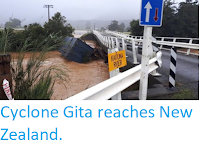Three people have died following a landslide at a quarry operated by Island Quarries at Suva on the southeast coast of the island of Viti Levu, Fiji, on Friday 20 March 2020. The dead men have been identified as David Johnson, the managing director of the quarry, Seci Roko, the quarry manager, and Aporosa Ratu, a mechanic employed at the site. The event happened amid heavy
rains and flooding associated with a low-pressure system that swept
across the islands. Landslides are a common problem after severe weather
events, as excess
pore water pressure can overcome cohesion in soil and sediments,
allowing them to flow like liquids. Approximately 90% of all landslides
are caused by heavy rainfall.
Rescue workers with the remains of a vehicle crushed by a landslide that killed three people at a quarry in Fiji on Friday 20 March 2020. Two of the bodies were found adjacent to the vehicle. Fiji Sun.
Fiji has a tropical climate, with a wet season that runs
from November to April, with peak rainfall in March, when over 360 mm of rain is usual, and a dry season that lasts from May to October.
However, the dry season is not completely arid, typically still receiving
about 150 mm of rain per month, and this year has been exceptionally
wet, with some of the heaviest rain ever recorded in the islands falling
in the past week, and local authorities are warning there is a danger
of further landslips and flooding.
The approximate location of the 20 March 2020 Suva landslide. Google Maps.
Low
presure systems are caused by solar energy heating the air above the
oceans,
which causes the air to rise leading to an inrush of air. If this
happens over a large enough area the inrushing air will start to
circulate, as the rotation of the Earth causes the winds closer to the
equator to move eastwards compared to those further away (the Coriolis
Effect). This leads to tropical storms rotating clockwise in the
southern hemisphere and anticlockwise in the northern hemisphere. These
storms tend to grow in strength as they move across the ocean and lose
it as they pass over land (this is not completely true: many tropical
weather systems peter out without reaching land due to wider atmospheric
patterns), since the land tends to absorb solar energy while the sea
reflects it.
The low pressure above tropical storms causes water to rise there by ~1 cm for every millibar drop in pressure, leading to a storm surge that can overwhelm low-lying coastal areas, while at the same time the heat leads to high levels of evaporation from the sea - and subsequently high levels of rainfall. This can cause additional flooding on land, as well as landslides.
See also...
Follow Sciency Thoughts on Facebook.







